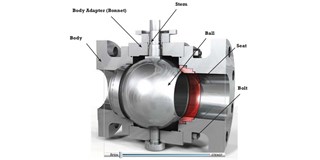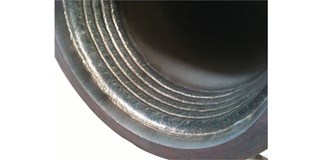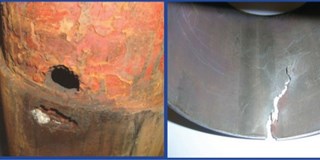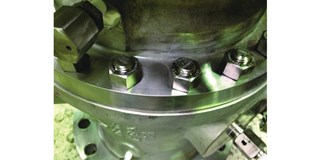Nickel alloys, which are alloys with nickel as the principal element, maybe used for piping as well as different parts of industrial valves such as body, bonnet, ball, seat, stem, bolting, spring, etc.
Valves are parts of piping systems and they are defined as components in the fluid flow which are used for different purposes. These purposes may involve stopping / starting the flow, controlling the flow rate, diverting the flow, preventing back flow and releasing the pressure [1] [2]. Figure 1 illustrates a ball valve, which is a rotary valve in which the ball shape closure member is rotated 90° to engage or disengage the port hole of the valve [2]. The ball in figure 1 is engaged to the port hole which keeps the valve open.

Figure 1. Ball valve in open position.
Introduction to valves and components
The different parts of the valve mentioned in this paper are defined as follows [3]:
Body: The valve body - also called the valve shell - is as the most important part of the valve assembly, keeping all the parts together like a framework. The body of the valve is the first pressure boundary receiving the fluid pressure. The valve body ends are designed to connect the valve to the piping.
Bonnet: Valve bonnet is the second most important pressure containing part; it covers the valve body and is manufactured in the same material as body of the valve.
Ball: The ball of the valve, also called ‘closure member’ [4] or ‘pressure controlling part ‘[4]stops or starts the fluid. When the valve closes, the full fluid pressure applies to one side of the ball so this part is considered as the third important pressure containing part of the valve [3].
Seat(s): Seats provide seating surface for the closure member.
Stem: The valve stem is the connector between the valve closure member and the operator and provides the necessary movement to the ball for closing and opening of the valve. The stem is connected to the hand wheel, lever or actuator from one side and to the valve closure member from the other side. An actuator is a component that is responsible for moving the valve internal automatically. Stems require high mechanical strength, especially in case of actuation, to withstand the loads applyied from the actuator side.
Bolting: Bolts are also pressure containing parts of the valves, used to connect valve body or bonnet pieces together.
Carbon steel pipe
Figure 2. Inconel 625 clad inside a carbon steel pipe.

Figure 2. Inconel 625 clad inside a carbon steel pipe.
Why specify nickel alloys?
There are various reasons to specify nickel alloys for the valves and the internals. These are summarized as follows:
Internal Corrosion: In a corrosive environment carbon steel piping maybe clad(overlaid internally) with 3mm nickel alloy (for example Inconel 625) to mitigate the risk of corrosion [5].
Corrosion attacks on pipes
Figure 3. CO2 (left) and H2S (right) corrosion attacks on pipes.

Figure 3. CO2 (left) and H2S (right) corrosion attacks on pipes.
The internal overlay of nickel alloy may be implemented for fluid services containing high amounts of corrosive compounds such as CO2 and hydrogen sulphide (H2S). CO2 and H2S corrosion attacks manifest in the form of metal loss and cracks, as illustrated in Figure 3.
Solid nickel alloy, Inconel 625 piping, is also common in the offshore sector of the oil and gas industry in hydrocarbon services with high amounts of H2S.
Consequently, in the parts of the world such as the Middle East where crude oil contains high concentrations of H2S, the valve bodies use in offshore oil and gas projects may be selected in Inconel 625 instead of 22Cr duplex. However, 22Cr duplex is a very common choice for piping and valves in the Norwegian offshore industry where oil and gas are either H2S free or levels are minimal [6]. Additionally, the sealing areas and the seat pockets of ball valves manufactured in carbon steel may be overlaid with Inconel 625 to avoid crevice corrosion. Crevice corrosion refers to a localised attack to the metal surface where there is a gap, crevice or groove.
External corrosion: Super duplex bolts are a common choice of material for valves manufactured in 22Cr duplex in the Norwegian offshore industry.
Duplex body valve
Figure 4. A 22Cr duplex body valve with Inconel 625 bolting and plug

Figure 4. A 22Cr duplex body valve with Inconel 625 bolting and plug
The maximum allowable operating temperature for uncoated super duplex material (e.g. bolting) in the offshore environment is 110°C [7] to avoid external chloride stress cracking corrosion in the marine environment. Therefore, super duplex bolting (bolts and nuts) are upgraded to Inconel 625 for 22Cr duplex valves in operating temperatures above 110°C as illustrated in Figure 4.

